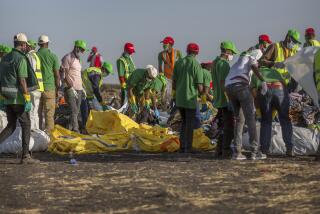Will the Bloated B-1B Be a Drag on the Stealth Bomber?
- Share via
The Pentagon’s new acquisition czar, Under Secretary of Defense Richard Godwin, is a man with a hefty problem--80,000 pounds, in fact.
That is how much weight Rockwell International’s B-1B bomber has taken on over the earlier B-1A. The extra weight is degrading the new bomber’s performance, and it could cost up to $4 billion to resolve the problem. Finding a solution may also delay the full operational capability of the B-1B fleet by as much as two years.
Godwin’s task is to try to solve the problem without embarrassing Secretary of Defense Caspar W. Weinberger and without focusing undue attention on the issue in a Democratic-controlled Senate.
After all, the Air Force has had more than seven years in which to flight-test the B-1B. If it still cannot design and build 100 B-1Bs for a fixed cost of $19.6 billion (in 1981 dollars), then questions about the production of the next-generation bomber, Northrop’s advance-technology “stealth,” are bound to surface.
Already the stealth bomber, which will not fly for at least two years, is approximately $1 billion over budget. Northrop and the Air Force are finger-pointing, each blaming the other for the cost growth.
But what makes Godwin’s task more formidable is that Weinberger, his old Bechtel Group buddy, is livid over the B-1B problems. The plane has been loudly trumpeted by the Reagan Administration as the hallmark of the President’s strategic modernization program. And Weinberger has been one of the bomber’s staunchest supporters. Now, according to top-level Administration officials, the secretary believes that the Air Force suppressed unfavorable data on the bomber and that “he was lied to about performance.”
The first 15 of the swing-wing B-1Bs are based at Dyess Air Force Base in Texas. This allows the Air Force to claim an initial operational capability for the planes, even though they may not fly regularly.
Air Force officials say that fixes have been identified for a number of problems, most of which equate to added weight and design changes from the B-1A to the B-1B.
For instance, wing-design changes and the added weight have induced drag at lower altitudes, reducing the B-1B’s range.
The drag problem, along with the failure of an actuator that moves the surfaces controlling the aircraft in flight--such as the flaps--caused the Dyess fleet to be grounded for about a week recently.
Another problem--”wet spots,” or fuel leakage--is believed by some to be caused by wing turbulence. The Air Force says that all large aircraft, including commercial airliners, have similar problems. The more hours the aircraft flies, the less it leaks, according to Air Force officers who claim to have developed a new sealant material.
Senior Pentagon officials counter that the Air Force and Rockwell used the wrong equations concerning the ability of the wings to withstand turbulence. This turbulence may cause torque that in turn is related to the fuel leaks, and may even be causing cracks integral to the fuel cells in the wing.
The turbulence also is believed to be severe enough to cause problems with cruise missiles carried on wing pylons. An air-launched cruise missile and a newer, longer-range version known as the advanced cruise missile have tumbled out of control after being launched from pylons.
When the bomb-bay doors are open, the B-1B also experiences a severe flutter related to turbulence. This makes it difficult to launch the arsenal of cruise missiles, nuclear-armed short-range attack missiles and bombs contained in the bay.
Other issues with the B-1B are unrelated to the airframe design. Eaton Corp.’s AIL Division is behind schedule in delivering the plane’s avionics system, which electronically deceives an enemy and defends the bomber. Even with a recovery plan to get the avionics back on schedule, the operational capability of the B-1B still will be delayed.
There is even serious doubt about the effectiveness of the system designed to protect the B-1B as it penetrates Soviet airspace.
Much faster than anticipated, the Soviets have developed and deployed a “look-down, shoot-down” radar system that is resistant to jamming. This could enable Soviet fighters, such as the MIG-31 Foxhound, to attack the B-1B from above.
This threat from the Foxhound now makes the stealth bomber even more attractive. But Godwin must handle the B-1B conundrum with alacrity to avoid embarrassing the Administration. Fixing the bomber’s problems could add an additional $30 million to the $200 million price tag for each aircraft. It will take at least two years to be certain that these fixes work, according to a senior Pentagon official.
Meanwhile, the Pentagon plans to seek approximately $5 billion in fiscal 1988 to begin production of the stealth bomber. If Congress should get the wrong signal on the B-1B, Democratic fence-sitters may first want to see the stealth fly before providing the full $60 billion for 132 of the advanced-technology bombers.
Thus Godwin not only must resolve the B-1B dilemma but also must handle the political dimension. Despite a new national-security decision directive now being formulated that includes planning for the bomber force, some in Congress detect a scent wafting across the Potomac toward the Hill. It might be the aroma of an over-ripe bird.
More to Read
Inside the business of entertainment
The Wide Shot brings you news, analysis and insights on everything from streaming wars to production — and what it all means for the future.
You may occasionally receive promotional content from the Los Angeles Times.










